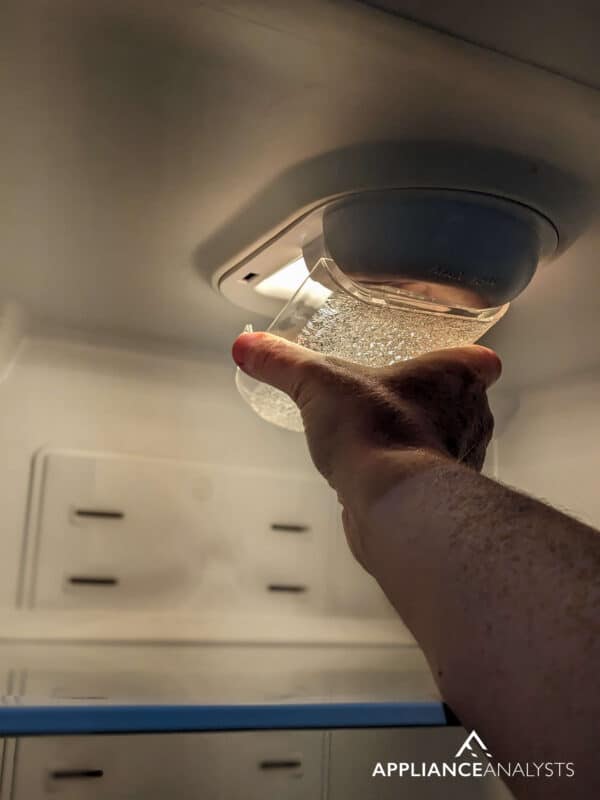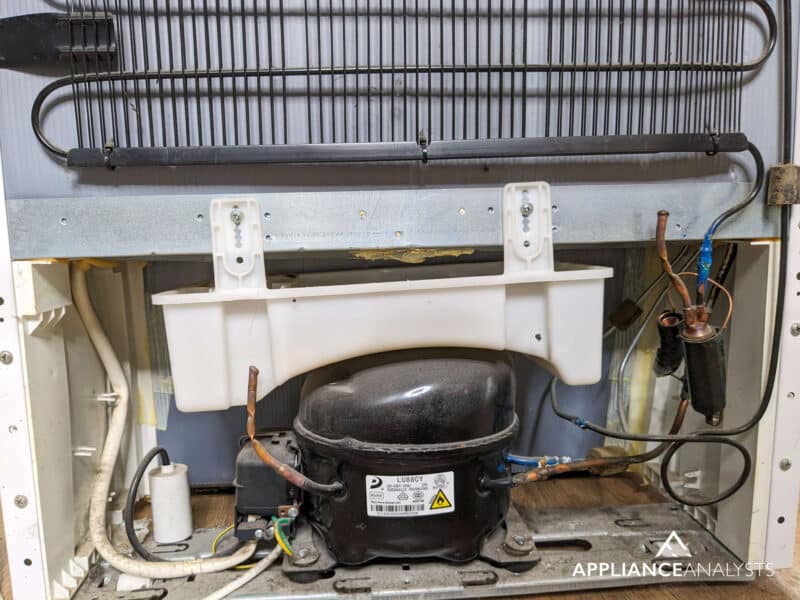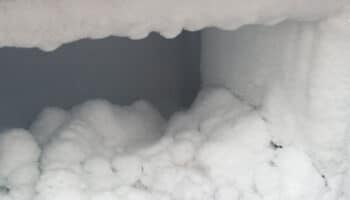We've independently reviewed this article to make sure it's as accurate as we can make it.
To find out more about our article creation and review process, check out our editorial guidelines.
Are you stuck trying to figure out why your fridge is raising your bills?
You’re not alone! I know how frustrating it can be to see the energy bills climb month after month, especially when you don’t understand why your fridge is causing the problem.
Don’t worry, though. I’m here to help.
If your fridge is raising your bills, consider its age, check the temperature settings, and examine the door seals and interior light. It’s also important to ensure proper airflow, inspect the defrost system, and check the compressor.
Read on to stay on top of your bills!
Why trust us? This article was written by Craig Anderson and Andy Fulenchek.
Craig has helped thousands of other homeowners repair their appliances since 2016.
Andy is one of our resident appliance repair experts with over a decade of experience. He currently runs his appliance repair company with a team of trusted technicians.
7 Ways to Reduce Your Fridge’s Energy Costs
In this section, I’ll explain the different reasons that can explain why your fridge is driving up your energy bills and offer multiple solutions.
Are you ready? Let’s dive in!
Click here to see how much it typically costs to run a refrigerator!
#1 Consider Your Fridge’s Age
In my experience, older refrigerators are more likely to contribute to increased bills.
You see, older fridges lack energy-saving features, and their components are often worn out, which makes the appliance run more often, raising your energy bills.
Additionally, the defrost system in traditional refrigerators is often controlled by a mechanical timer that triggers the defrost cycle at set intervals, regardless of whether defrosting is actually needed, leading to increased bills.
So, if your refrigerator is over 12 years old and you’ve noticed it’s not working well and causing your bills to go up, it’s likely a good time to get a new one.
Consider getting an Energy Star-certified fridge, which is designed to use as little power as possible while meeting all the necessary requirements.
However, if you’re not looking to replace your fridge or if it isn’t too old, please read the next tips.
#2 Check the Temperature Settings
I always check the fridge’s temperature when my energy bills go up.
If you set your refrigerator to a colder setting than it actually needs, it will work harder to maintain the lower temperature. As a result, your fridge will run more often and increase your energy bills.
Refrigerators should ideally be set between 3 °C (37.4 °F) and 5 °C (41 °F). But please check your manual for the manufacturer’s specific recommendations.
You can check your fridge’s temperature with an appliance thermometer. However, If you don’t have one, simply place a glass of water on the middle shelf overnight. Then, insert a regular thermometer into the water.
If your refrigerator is too cold, please adjust the temperature dial. Keep in mind that the highest number in the dial typically corresponds to the coldest setting.
While you’re at it, please make sure your fridge is placed away from direct sunlight or heat sources, like ovens or dishwashers. If the room temperature is too high, your refrigerator will struggle to maintain its coolness, leading to increased energy consumption.
If your refrigerator is located in the garage, make sure it’s a “garage-ready” model, which is built to withstand higher temperatures.
#3 Examine the Door Seals
Believe it or not, your fridge’s door seal could be the culprit behind your increased bills.
When the door seal gets dirty, worn out, or damaged, it can let the cold air escape while allowing warm air from outside to enter, making the fridge work overtime to keep the interior cold. As mentioned above, when your fridge cycles too often, the energy consumption increases.
Don’t worry, though. Checking your refrigerator’s door seal is very simple. First, you need to clean the gasket with warm water and vinegar. You can also use a kitchen cleaner, but please avoid bleach.
Then, look for any signs of damage, such as cracks or dryness. You can also try the paper test, which consists of closing the door with a piece of paper or dollar bill halfway in and halfway out of the fridge. Then, try pulling out the piece of paper. Does it slide out easily? If so, it’s time to replace the seal.

If your door seals are not the issue, please avoid opening the door too often. Doing so can allow warm air to enter and force your fridge to work harder. So, before opening the refrigerator, take a moment to think about what you need.
#4 Check the Interior Light
If your fridge is raising your bills, it’s also important to check the interior light.
Normally, the interior light will only turn on when the door opens. However, if the door switch is not working, it could signal that the door is open even when it’s not, causing the light to stay on, which not only consumes electricity but also generates heat.

In my opinion, the easiest way to check if the interior light is turned on even with the door closed is by recording a video. Simply place your phone inside the fridge, close the door, and wait a few minutes. Then, grab your phone and watch the video.
If the light stays turned on, please replace the door switch with a new, compatible one.
#5 Ensure Proper Airflow
My usual advice when fixing a fridge causing the energy bills to go up is to check for airflow issues.
You see, good airflow will help maintain the desired temperature, preserve your food, and reduce the strain on the compressor, resulting in lower energy bills.
Here’s how to ensure proper airflow in your refrigerator:
- Avoid blocking the vents inside your fridge and freezer. If necessary, organize your food containers. Allow some space between items.
- Don’t overload your fridge. Doing so can restrict airflow and lead to inconsistent temperatures.
- Ensure enough breathing room. Make sure there’s at least a 1-2 inch gap between your fridge and the walls to allow the condenser coils to dissipate heat properly.
- Check the fans. Make sure the evaporator and condenser fans move freely. If they’re stuck or faulty, please get a replacement.
- Clean the condenser coils. Dust can keep your fridge’s coils from properly releasing the heat generated during the cooling process. As a result, your fridge will need to work harder and use more electricity.
- Check for frost buildup. Ice can block the air channels and cause temperature issues.
- Inspect the damper door. In single-evaporator fridges, the damper door controls how much cold air moves from the freezer to the refrigerator. Access the damper door and check if it’s stuck or faulty. If it is, replace it with a new one.

#6 Inspect the Defrost System
A faulty defrost system can also explain why your fridge raises your energy bills.
Your refrigerator’s defrost system is responsible for melting the accumulated frost from the evaporator coils and ensuring the unit’s cooling efficiency.
Unfortunately, if one of the components in the defrost system malfunctions, it can either cause your fridge to run more frequently or lead to frost buildup, both of which contribute to higher energy bills.
In such cases, I recommend accessing the defrost heater, timer, and thermostat and testing them with a multimeter for continuity. If one of the parts is faulty, please get a replacement.
If you’re not comfortable diagnosing or replacing the defrost system components yourself, it’s best to consult your warranty and call a professional. They’ll be able to identify the issue and fix it.
#7 Check the Compressor
If you’ve tried all the fixes above, but your fridge keeps raising your bills, the compressor is probably malfunctioning.

You can think of the compressor as the heart of your refrigerator, as it compresses and circulates the refrigerant to keep the interior cool.
When the compressor first starts, it consumes a significant amount of power, typically between 8 and 10 amps. Once it’s up and running, it just draws 1-1.5 amps. Unfortunately, if the compressor struggles to start but fails, it will continue drawing around 8 amps, which leads to increased bills.
I find that problems with the compressor are expensive to repair and require a professional. So please check your warranty status and consider that, more often than not, replacing the entire fridge is more cost-effective.
Wrapping Up: Your Guide to a More Energy-Efficient Fridge
Hopefully, now you know how to keep your fridge from raising your bills.
Remember to consider your refrigerator’s age, as older models tend to contribute to increased bills. Don’t forget to make sure your fridge is set to the right temperature, examine the door seals, and check the interior light.
It’s also important to ensure proper airflow to prevent temperature issues and check the defrost system components and compressor.
Thank you so much for taking the time to read this guide. If you found it helpful, please check out our related articles. We love helping people fix all sorts of appliances.
Have a wonderful rest of the day!










